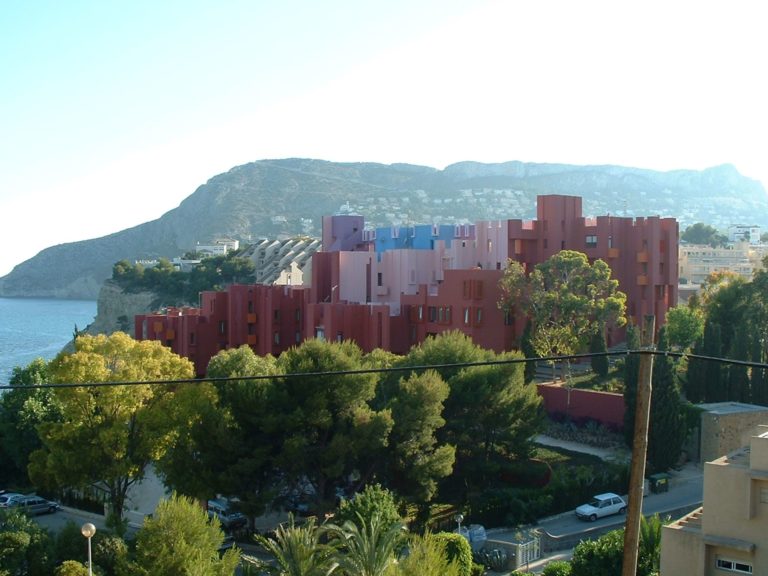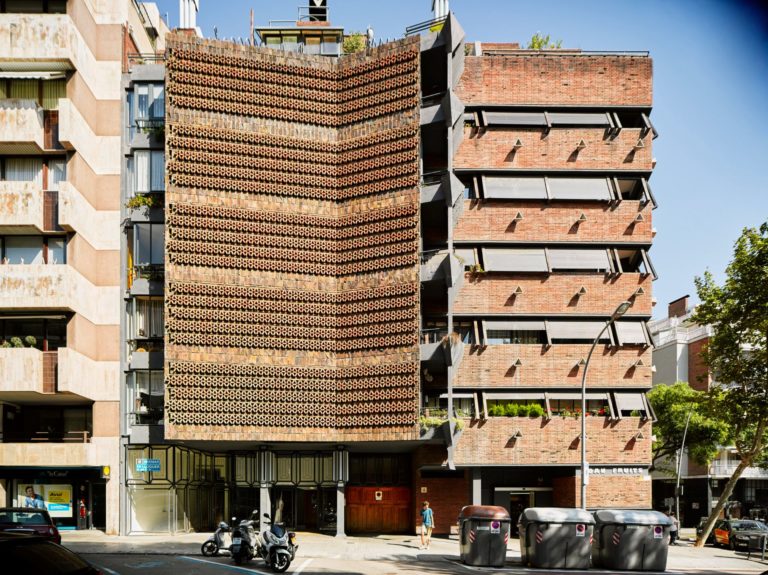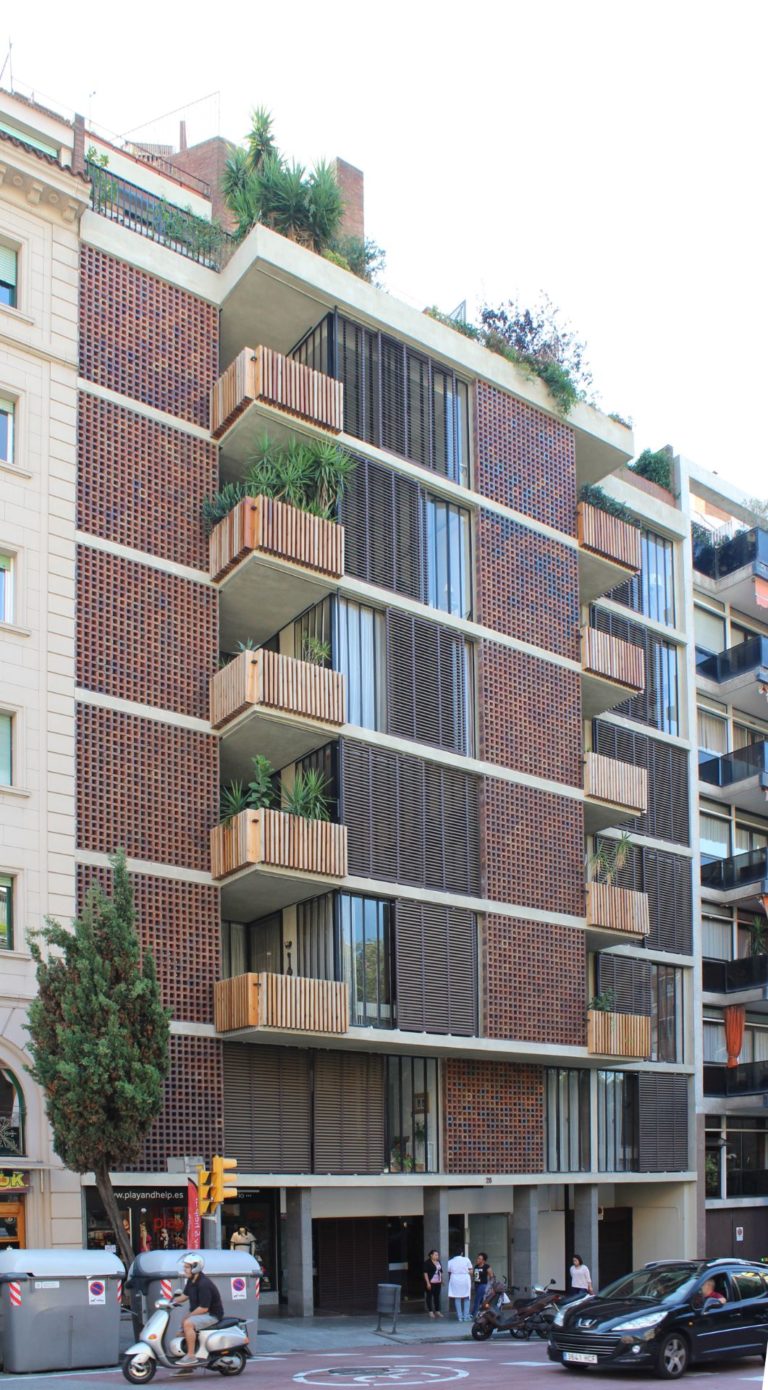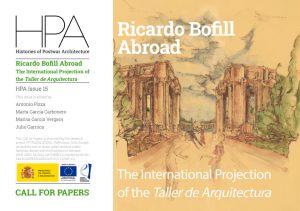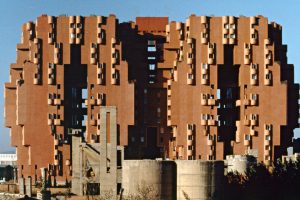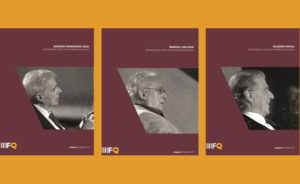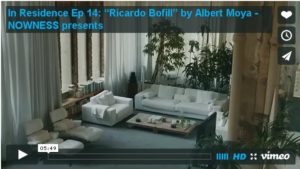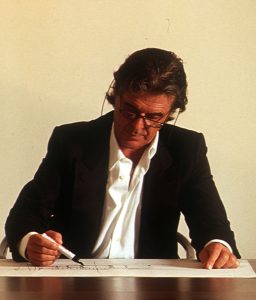
Ricardo Bofill Levi
Barcelona, 1939-2022
Son of the architect and builder Ricardo Bofill Benessat and the Venetian Maria Levi, Ricardo Bofill Levi was born in Barcelona in 1939, where he began his studies of architecture, although he earned his degree from the Geneva School of Architecture in 1962. In 1963, he founded the Taller d’Arquitectura (RBTA), a team formed by architects, engineers, sociologists and writers – including the English architect Peter Hodgkinson (starting in 1966) and the Frenchman Jean-Pierre Carniaux (starting in 1976) – who rounded out the Taller’s international contingent. Today, the Taller is a studio with offices in Paris (1978), New York (1979), and Barcelona, where the headquarters it has occupied since the 1970s, La Fàbrica, an old cement factory renovated by the Taller, is perhaps the first model intervention in Spanish industrial heritage.
A child prodigy, who was unruly and imaginative, he had an immense capacity for finding new ways to spark the interest of critics and politicians, while stirring the pot with his work and turning his inventions into a commercial brand. The first phase in his career, through 1975, which had a certain hippie quality yet was framed by the gauche divine, centred on experiments with residential buildings that are theorized in his book: Towards a Formalization of the City in Space (1968). The projects and complexes for the Gaudí District in Reus, La Manzanera in Calp, Walden 7 in Sant Just Desvern, and The City in Space in Moratalaz represent an urban alternative to the neighbourhoods formed by seried residential blocks typical of the International Style, instead combining private domestic uses with the shared uses of leisure in a single structure. These volumetric configurations, the result of modular combinations, achieved a visibility in the foreign media that was unprecedented for Spanish architecture up to that time. They were not as well-received at home, with the exception of Òscar Tusquets, due to the impact of their striking colours, innovative textures, and monumental scale. It is not surprising that Ricardo Bofill became one of the first “starchitects”. In 1973, he received the Creu de Sant Jordi (Saint George’s Cross) from the Government of Catalonia.
The three projects that formed the winning competition entry for Les Halles de Paris (1973-1975) confirmed a definitive linguistic turn towards a prefabricated and didactic classicism, both for their Beaux Arts semantics and syntax in plan, and for their new urban principles in which squares and streets played the role of shaping neighbourhoods. This was the beginning of a second prolific professional phase, with its epicentre in France, and which continued through the year 2000. The text “Les Espaces d’Abraxas: the Palace, the Theatre, the Arch” (1981) accounts for this new industrially produced iconographic repertoire that ended up colonizing large stretches of Saint-Quentin-en-Yvelines (the Arcades, the Viaduct, the Palaces), Marne-la-Vallée (the Palace, the Theatre and the Arch), and Cergy-Pontoise (the Columns) on the outskirts of Paris and in Montpellier, in what has been called “the people’s Versailles”. Comparable projects were also built outside France, with neighbourhoods in The Hague, Stockholm, Baghdad, Beijing, and agricultural towns in Algeria. RBTA will be remembered, among other things, for its kaleidoscopic imagery associated with social housing. The MoMA sanctified this movement with the exhibition Architecture, Urbanism and History (1985) on Bofill and Leon Krier. It received honours in the US (1985) and in France (1988 and 1995).
Before the turn of the new millennium, RBTA had achieved the status of an internationally prestigious firm. Two new professional fronts proved especially fertile: the design of green spaces, in a defence of sustainability; and large facilities and corporate headquarters catering to the world of high tech. The Turia River Gardens (València 1981), the Riouxa Park (Vigo 1991), the Manzanares Park (Madrid 2003), the plan for the Moscow Agglomeration (2012), and the proposal for the Noble Qur’an Oasis in Saudi Arabia (2014) all show this commitment to contact with a domesticated nature, sometimes designed using imposing geometric shapes inspired by the Baroque. On the other front, in which a simplified classicism and high technology come together, the Madrid Congress Centre (1993), the National Theatre of Catalonia (1997), the T1 (1991) and T2 (2010) airport terminals in Barcelona, and the Qingdao Airport (2013), as well as the West Wacker Drive skyscrapers in Chicago (1992), the Casablanca Twin Centre (1998) and the Hotel Vela in Barcelona (2009) show this process of abandoning historicist gestures to embrace the technological future. For his constant commitment to the discipline and to geometric precision, it is impossible to deny Bofill’s stature as one of the masters. Bofill died in Barcelona in 2022. The Polytechnic University of Catalonia had awarded him an honorary doctorate the previous year.
Biography by Andrés Martínez-Medina and Justo Oliva Meyer
Bibliography
- SERRELL, Dominique, Ricardo Bofill: les années françaises – he french years, Norma Editions, Paris, 2023.
- BOFILL LEVI, Ricardo, TALLER DE ARQUITECTURA, La Fábrica, Apartamento Publishing, Barcelona, 2022.
- CÁNOVAS, Andrés, ESPEGEL, Carmen, MUXÍ, Zaida, Edificio Walden 7 – Walden 7 building: Ricardo Bofill, Taller de Arquitectura. Barcelona, 1970-1975, DPA Prints, Barcelona/ETSAM, Madrid, 2021.
- FERNÁNDEZ GALIANO, Luis, Maestros españoles 2, Arquitectura Viva, Madrid, 2021.
- JEDRUCH, Dorota, Blok jako dzieło sztuki: trzy modele architektury socjalnej w XX-wiecznej Francji: Le Corbusier, Émile Aillaud, Ricardo Bofill, Universitas, Krakovia, 2020.
- KLANTEN, Robert, NIEBIUS, Maria Elisabeth, MARINAI, Valentina, eds., Ricardo Bofill: visions of architecture, Die Gestalten Verlag, Berlin, 2019.
- KLANTEN, Robert, NIEBIUS, Maria Elisabeth, MARINAI, Valentina, eds., Ricardo Bofill: visions d’architecture, EPA, Vanves, 2019.
- GRUNTZ, Lukas, Les traits de Bofill a Paris: Architektur und Identität oder Ricardo Bofill und seine Phalanstères der Postmoderne, Verlag Das Archiv, Nidau, 2019.
- AA VV, Estudio y Catalogación de 400 edificios significativos de la arquitectura del Movimiento Moderno realizada en España entre 1965-1975 (vol. 2º), Ministerio de Cultura y Deporte/Fundación Docomomo Ibérico, Madrid, 2018.
- FERNÁNDEZ GALIANO, Luis, ÚBEDA, Joan, MONRÁS, Arnau, Ricardo Bofill, Fundación Caja de Arquitectos, Barcelona, 2015 (dvd).
- BOFILL LEVI, Ricardo, CHAN, Carson, Ricardo Bofill: the future of the past, Mono.Kultur, Berlin, 2014.
- BOFILL LEVI, Ricardo, BORGES, Sofía, BAGUÉ, J., CARBONELL, C. C., Ricardo Bofill: Taller de Arquitectura, Andrew Ghadimi, Barcelona, 2013.
- BOFILL LEVI, Ricardo, LUCIVERO, Alessandra, Ricardo Bofill, Hachette Fascicoli, Milano, 2010.
- BOFILL LEVI, Ricardo, TALLER DE ARQUITECTURA, Vela Building, Mediúscula, Barcelona, 2010.
- CENTELLAS SOLER, Miguel, JORDÁ SUCH, Carmen, LANDROVE BOSSUT, Susana, coords., La vivienda moderna. Registro DOCOMOMO Ibérico, 1925-1965, Fundación Caja de Arquitectos/Fundación Docomomo Ibérico, Barcelona, 2009.
- BOFILL LEVI, Ricardo, TALLER DE ARQUITECTURA, Architecture in the Era of Local Culture and International Experience, Autores, Barcelona, 2009.
- COLOMER SENDRA, Vicente, ALONSO DE ARMIÑO, Luis, dirs., Registro Arquitectura del siglo XX en la Comunitat Valenciana. Valencia: Generalitat Valenciana (2 vols.), COACV/UPV/IVE/GV, Valencia, 2002.
- GRANELL I MARCH, Jordi, MARTÍNEZ-MEDINA, Andrés, CORRAL JUAN, Luis, LÓPEZ MARTÍNEZ, José María, VILLANUEVA PLEGUEZUELO, Eusobio, PÉREZ AMARAL, Arsenio, dirs. y coords., La arquitectura del sol_Sunland architecture, Barcelona, Colegios de Arquitectos de Catalunya, Comunitat Valenciana, Illes Balears, Murcia, Almería, Granada, Málaga, Canarias, 2002.
- BOFILL LEVI, Ricardo, TALLER DE ARQUITECTURA, Commercial arts Ricardo Bofill, Springer, Wien, 2001.
- BOFILL LEVI, Ricardo, La ciudad del arquitecto, Galaxia Gutemberg-Círculo de Lectores, Barcelona, 1998.
- BRADASCHIA, Maurizio, ed., Ricardo Bofill & Jean-Louis André, Spazi di una vita. Cardo Editori, Venecia, 1996 (orig. Editions Odile Jacob, Paris, 1989).
- BOFILL LEVI, Ricardo, VÉRON, Nicolas, L’Architecture des villes, Odile Jacob, Paris, 1995.
- GOYTISOLO, José Agustín, Taller de Arquitectura, Lumen, Barcelona, 1995 (orig. Barcelona, Blume, 1976).
- CRUELLS, Bartomeu, Ricardo Bofill, Zanichelli, Bolonia, 1994.
- BOFILL LEVI, Ricardo, TALLER DE ARQUITECTURA, Memory-Future, Edicion de los autores, Barcelona, 1993.
- CRUELLS, Bartomeu, Ricardo Bofill, Gustavo Gili, Barcelona, 1992.
- BOFILL LEVI, Ricardo, TALLER DE ARQUITECTURA, Barcelona Airport, Edizioni Tecno, Milano, 1991.
- BOFILL LEVI, Ricardo, ANDRÉ, Jean Louis, Espacio y vida, Tusquets Editores, Barcelona, 1990.
- BOFILL LEVI, Ricardo, TALLER DE ARQUITECTURA, Ricardo Bofill, Taller de Arquitectura. De Beurs van Berlage, Amsterdam, 1989 (exhibition catalogue).
- D’HUART, Annabelle, Ricardo Bofill: Taller de Arquitectura, Electa, Milano, 1989.
- D’HUART, Annabelle, Ricardo Bofill, Electa/Editions du Moniteur, Paris, 1989.
- AA VV, El Jardí del Turia, Ajuntament de València, València, 1987.
- WARREN, James A., Ricardo Bofill, Taller de Arquitectura. Edificios y Proyectos, 1960-1985,Barcelona, Gustavo Gili, 1988 (orig. New York, Rizzoli, 1987).
- BOFILL LEVI, Ricardo, VÁZQUEZ VÁZQUEZ F., WACHS, A., Ricardo Bofill, Taller de Arquitectura: La Coruña, el mar y la ciudad, Ayuntamiento de La Coruña, La Coruña, 1986 (exhibition catalogue).
- CORTÉS, Juan Antonio, ”The Green Crescent”, en Arquitectura 258, 1986, p. 61.
- LAHUERTA, Juan José, “The Green Crescent”, París 1985. Cersy Pontoise. Las ranas pidiendo rey”, in Arquitectura 258, 1986, p. 56.
- TUSQUETS BLANCA, Óscar, “Sobre Bofill”, in Arquitectura 258, 1986, pp. 23-24.
- RUBERT DE VENTÓS, Xavier, “Del post-modernismo a Ricardo Bofill”, in Arquitectura, 258, 1986, pp. 48-49.
- PÉREZ ESCOLANO, Víctor, “Les Echelles du Baroque. París XIV. 1985”, in Arquitectura 258, 1986, p. 60.
- FULLAONDO, Juan Daniel, “Diálogo en torno a Bofill”, in Arquitectura 258, 1986, pp. 64-66.
- TUSQUETS BLANCA, Óscar, “El Anfiteatro: veintisiete apartamentos en La Manzanera. Calpe Alicante. 1983”, in Arquitectura 258, 1986, págs. 42-44.
- FUTAGAWA, Yukio, NORBERG-SCHULZ, Christian, BOFILL, Ricardo, Ricardo Bofill: Taller de Arquitectura, Tokyo, ADA, (Global Architecture), 1985.
- NORBERG-SCHULZ, Christian, Ricardo Bofill: Taller de Arquitectura, New York, Rizzoli, 1985.
- BOFILL LEVI, Ricardo, KRIER, Leon, Architecture, Urbanism and History, Museum of Modern Art, Nueva York, 1985.
- D’HUART, Annabelle, Ricardo Bofill, taller de arquitectura: el dibujo de la ciudad, industria y clasicismo, Gustavo Gili, Barcelona, 1985.
- D’HUART, Annabelle, Ricardo Bofill: taller de Arquitectura: die Gestaltung der Stadt Industrie und Klassizismus, Karl Krämer, Sttutgart, 1985.
- GLOBAL ARCHITECTURE, Ricardo Bofill & Taller de Arquitectura, ADA, Tokyo, 1985.
- HÉBERT-STEVENS, François, La arquitectura de un hombre (Conversaciones con François Hébert-Stevens), Ediciones Grech, Madrid, 1984.
- D’HUART, Annabelle, Ricardo Bofill: Taller de Arquitectura, Gustavo Gili, Barcelona, 1984.
- GLOBAL ARCHITECTURE, Abraxas, ADA, Tokio, 1983.
- BOFILL LEVI, Ricardo, GUEDES, Pedro, HODGKINSON, Peter, JENCKS, Charles, Taller de Arquitectura, Ricardo Bofill, Architectural Association, Londres, 1981 (catálogo de exposición).
- BOFILL LEVI, Ricardo, La cité: histoire et technologie: projets français 1978-1981, L’Equerre, Paris, 1981.
- BOFILL LEVI, Ricardo, Los espacios de Abraxas: El Palacio, El Teatro, El Arco, Electa, Milano, 1981.
- GLOBAL ARCHITECTURE, House 9, ADA, Tokyo, 1981.
- GLOBAL ARCHITECTURE, Biennale, ADA, Tokyo, 1980.
- BOFILL LEVI, Ricardo, L’Architecture d’un homme, Editions Arthaud, Paris, 1978.
- GLOBAL ARCHITECTURE, Walden-7, ADA, Tokyo, 1976.
- FUTAGAWA, Yukio, ed., Taller de Arquitectura. La Manzanera, Calpe, Spain, 1966, 1972. El Castell, Sitges, Spain, 1967, ADA, Tokyo, 1973.
- “La arquitectura de Ricardo Bofill”, in Revista de Occidente 1, 1973, pp. 42-60.
- BOFILL LEVI, Ricardo, Hacia una formalización de la ciudad en el espacio, Blume, Barcelona, 1968.
- BOFILL LEVI, Ricardo, “Sobre la situación actual de la arquitectura en España”, in Zodiac 15, 1965, pp. 34-43.
